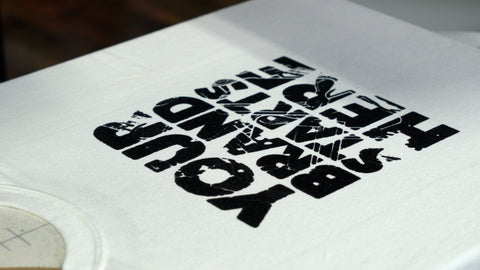So you want to decorate garments. There are so many ways of doing that. Do you want to use transfers? Interested in direct-to-garment printing? Want to try out screen printing? With so many options to start, it can be overwhelming for a DIY printer to decide. Let’s compare two popular methods: DTF and screen printing.

WHAT IS DTF?
DTF means Direct-to-film. This references a type of printer that prints the design directly to the transfer film, and then is heat pressed onto various garments and other substrates. This method can be used for just about any clothing type and creates a transfer that feels like a soft vinyl transfer. DTF is great for small print runs of just a few shirts, difficult substrates like backpacks, or to utilize all the colors of the rainbow with just one film.
WHY SCREEN PRINT?
Screen printing takes a bit more learning to get good at, but can have a huge payout. New printers need to be patient with themselves and learn the trade. It’s much more nuanced than heat pressing a transfer.
But there are some benefits to screen printing that DTF doesn’t have. Properly cured screen printed garments will last longer than DTF transfers. Because DTF is a transfer, creating large prints won’t have a soft hand feel. For a great soft print, head to screen printing. The transfer sits on top of the shirt instead of soaking in as a screen print would. Screen prints are softer and flex with the shirt.
Screen printing wins when printing large jobs, hands down. When decorating small runs, like for a family vacation, setting up a screen print job might not be worth the cost. But if you’re printing for a family reunion, sports team, or any job over 25 prints, screen printing is the way to go.
RELATED: WHY SHOULD I START SCREEN PRINTING?

COMBINE THE TWO WORLDS
There’s a place in garment decoration for both screen printing and DTF (or any type of transfer).
Say you’re printing shirts for a local kids’ softball team. You need to print at least 30, but every shirt needs to have a different number and name on the back.
Since the team’s name and design will be the same for the whole team, screen print it. Then, use DTF transfers to create the numbers and names of each player. Combining decoration methods is a great way to diversify your offerings and create a niche for your shop.
RELATED: SHOULD I SCREEN PRINT OR DECORATE WITH VINYL?
WHAT’S THIS ALL GOING TO COST?
When starting a business, there’s always an investment involved. Let’s compare the cost of both methods. First up, screen printing.
SCREEN PRINTING
Say you’re investing in the Riley Hopkins 150 kit, which has a small press, ink, screens, squeegees, scoop coaters, an exposure bulb or small unit, and more. Let’s say you’re printing with the Riley Hopkins 150 Complete Screen Printing Kit. That brings your total to approximately $1,900 before tax and shipping.
Add up other costs, like the number of utilities it takes to run the shop and the cost of ink and emulsion per design. Take the print below for example.

This is a one-color image, so the cost of ink per shirt is approximately 20 cents. Multiply that by 30 shirts, and you’re looking at about $6.00 of ink cost for the job. The emulsion should only be a few cents since you’d only need to coat one screen for this job.
So how much should you charge per shirt to make a profit? Generally, printers try to make up to 45% profit on a print job. Here’s a table to help you determine that:
| total cost per item |
| x percent of desired profit as a decimal (example: .25 or .45) |
| = profit made per item per job |
RELATED: CALCULATING SCREEN PRINTING PROFITS FOR A DIY PRINTER IN 4 STEPS
Now let’s talk about the profitability of DTF.
DTF
A low-end DTF machine will run about $3,500. You’ll need special ink and film too, plus a heat press. This start-up cost is more than a beginner screen printing kit but can have benefits.
You’ll be able to start printing top-notch prints right away and can use every color of the rainbow without trying to produce it in CMYK. Simply set your printer and walk away. With DTF, you can print a handful of shirts, or just one.
Use the same calculator as the section above to calculate how much profit you’d make using DTF transfers. Compare the costs and profits to whichever method speaks best to your setup and process.
RELATED: HOW SCREEN PRINTING CONSTANTLY EVOLVES TO FIT AN EVER-CHANGING WORLD

Both screen printing and DTF have their niches in the world. It all depends on what you’re looking for in garment decoration and what you want to provide. The best way to know? Ask around and see what print shops like yours are doing. Try both out and see which you like better.

